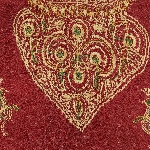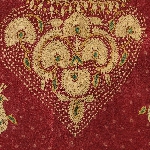| Native Name | Jhabla |
| Object Number | A613 |
| Current Location | Collections Storage |
| Culture | Indian | Parsi |
| Provenience | India | Gujarat | Surat |
| Period | 19th Century |
| Date Made | Mid to Late 19th Century |
| Section | Asian |
| Materials | Silk |
| Technique | Embroidered | Bandhani | Tie Dyed | Woven | Sewn |
| Iconography | Peacock | Bird |
| Description | Satin-weave (gajji) silk tunic for a Parsi child or woman (jhabla) dyed deep red in the chunari bandhani technique and embroidered with cream, golden yellow, green, and bright blue floss silk embroidery thread. In chunari-style bandhani, small puckers of fabric are tightly bound with string to create small spots that resist the application of dye. The neckline of this jhabla is related to other collarless garment forms rooted in the Central Asian tunic, often cut with a deep neck opening that can be tied at the top, such as the kurta and aba. Throughout Central Asia, the Iranian Plateau, and the Indian Subcontinent, these neck openings are often a site for elaborate embroidery, and the pendant-like ornament beneath it references necklaces. Peacocks are a prominent motif in Gujarati embroidery, and the arrangement of two peacocks flanking a pendant neckline is a common composition for Parsi jhabla. The technique of embroidering atop simple bandhani designs is used throughout Gujarat, particularly by pastoral communities in the Kachchh (Kutch) and Banni regions. Both the use of bandhani and many of the embroidery stitches used are related to textile traditions in Rajasthan and Sind, which are united with Kachchh and Banni by the Thar Desert. The embroidery is worked in a technique called mochi bharat (mochi work, also called ari bharat), a chain-stitch technique done with a small, hooked needle called an ari (or aari). The stitches forming the prominent circular and semi-circular shapes on this jhabla are elaborated eyelet buttonhole stitches; the thick waving line in the border design is created with ladder stitch; every other part of the design is worked in chain stitch, including the individual ‘knots,’ which are isolated chain stitches. This jhabla and others worked in a similar style of mochi bharat most likely in Surat, Gujarat share many of the techniques and designs used by mochi embroiderers for other markets outside of the Parsi community. |
| Length | 53 cm |
| Width | 42 cm |
| Credit Line | Purchased from F. P. Bhumgara & Company, 1904 |
Report problems and issues to digitalmedia@pennmuseum.org.






